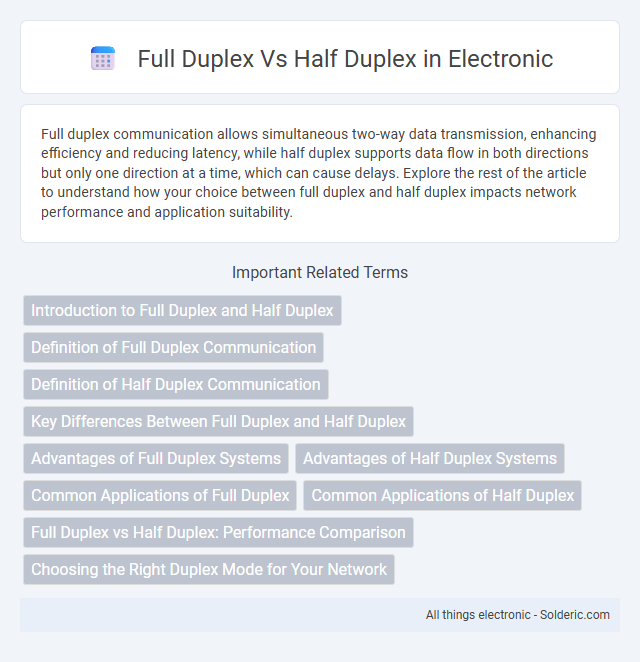Full duplex communication allows simultaneous two-way data transmission, enhancing efficiency and reducing latency, while half duplex supports data flow in both directions but only one direction at a time, which can cause delays. Explore the rest of the article to understand how your choice between full duplex and half duplex impacts network performance and application suitability.
Comparison Table
| Feature | Full Duplex | Half Duplex |
|---|---|---|
| Communication Direction | Simultaneous two-way | One-way at a time |
| Data Transmission | Send and receive concurrently | Send or receive alternately |
| Latency | Lower latency | Higher latency due to switching |
| Use Cases | Telephones, modern Ethernet | Walkie-talkies, traditional Ethernet |
| Bandwidth Utilization | More efficient | Less efficient |
| Complexity | Higher complexity | Lower complexity |
Introduction to Full Duplex and Half Duplex
Full duplex and half duplex are communication modes that define how data transmission occurs between devices. Full duplex enables simultaneous two-way communication, allowing data to flow in both directions at the same time, enhancing network efficiency and reducing latency. Half duplex permits data transmission in only one direction at a time, which may cause delays but requires simpler hardware, affecting your choice based on network requirements and device capabilities.
Definition of Full Duplex Communication
Full duplex communication allows data to be transmitted and received simultaneously between two devices, enabling continuous two-way interaction without delay. This method is commonly used in telephone networks and modern Ethernet systems, where both parties can send and receive signals at the same time. Your network efficiency and responsiveness improve significantly with full duplex communication compared to half duplex, which allows data flow in only one direction at a time.
Definition of Half Duplex Communication
Half duplex communication allows data transmission in both directions but only one direction at a time, meaning devices take turns sending and receiving signals. This mode is commonly used in walkie-talkies and traditional Ethernet networks, where simultaneous two-way communication is not required. It contrasts with full duplex systems that enable simultaneous data flow in both directions, enhancing communication efficiency.
Key Differences Between Full Duplex and Half Duplex
Full duplex communication allows simultaneous two-way data transmission, while half duplex permits data flow in only one direction at a time. In full duplex, devices can both send and receive signals concurrently, improving efficiency and reducing latency, unlike half duplex which requires alternating between sending and receiving. Full duplex is commonly used in modern Ethernet networks and telephone systems, whereas half duplex is typical in walkie-talkies and traditional CB radios.
Advantages of Full Duplex Systems
Full duplex systems enable simultaneous two-way communication, significantly increasing data transmission efficiency and reducing latency in network environments. This capability enhances real-time applications like video conferencing, online gaming, and VoIP, offering seamless interaction and improved user experience. Moreover, full duplex technology optimizes bandwidth utilization, minimizing collisions and boosting overall network performance.
Advantages of Half Duplex Systems
Half duplex systems offer the advantage of simplified communication protocols, reducing hardware complexity and cost compared to full duplex systems. They are ideal for environments where bandwidth is limited or where communication occurs in one direction at a time, ensuring efficient use of your available resources. Maintenance and troubleshooting are also easier in half duplex systems due to their straightforward transmission and reception cycle.
Common Applications of Full Duplex
Full duplex communication is commonly found in modern telecommunication systems, such as telephone networks and VoIP calls, enabling simultaneous two-way audio transmission for natural conversations. It is integral to Ethernet networks using switches, allowing devices to send and receive data concurrently, thereby improving network efficiency and reducing collisions. Wireless communication protocols like LTE and Wi-Fi also utilize full duplex techniques to enhance throughput and reduce latency in data transfer.
Common Applications of Half Duplex
Half duplex communication is widely used in walkie-talkies, where users transmit and receive voice signals alternately on a single channel to avoid collisions. It is also common in traditional CB radios and some wireless communication systems like RFID, where devices take turns to send and receive data. Additionally, half duplex is preferred in industrial control systems and point-to-point communication links with limited bandwidth to ensure efficient use of the transmission medium.
Full Duplex vs Half Duplex: Performance Comparison
Full duplex communication enables simultaneous two-way data transmission, significantly enhancing network throughput and reducing latency compared to half duplex systems, which only allow data flow in one direction at a time. In full duplex mode, devices avoid collision and wait-time inefficiencies, resulting in more efficient bandwidth utilization and faster communication speeds. Half duplex systems typically face performance bottlenecks in high-traffic environments due to collision detection and retransmission requirements, limiting overall data transfer rates.
Choosing the Right Duplex Mode for Your Network
Selecting the appropriate duplex mode for your network hinges on balancing performance and hardware compatibility. Full duplex enables simultaneous two-way data transmission, reducing collisions and doubling effective bandwidth, ideal for modern LAN switches and network devices. Half duplex restricts communication to one direction at a time, suitable for legacy equipment or environments where simplicity and cost-efficiency take precedence over speed.
Full duplex vs Half duplex Infographic

 solderic.com
solderic.com